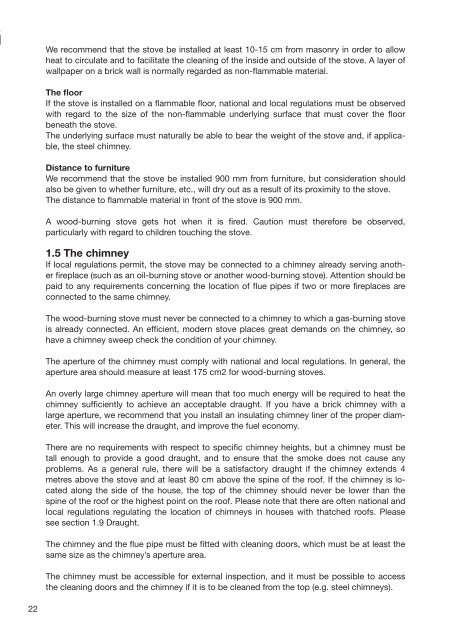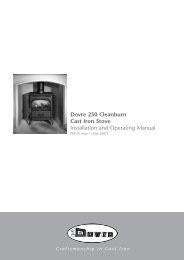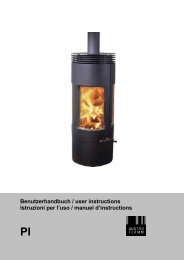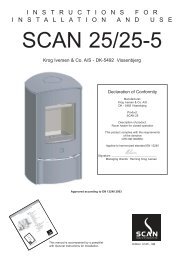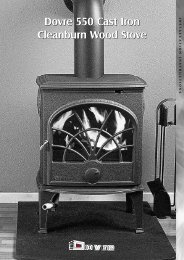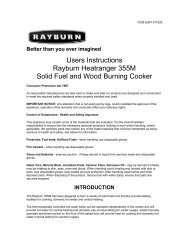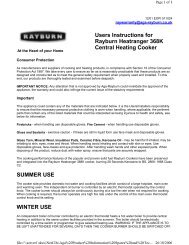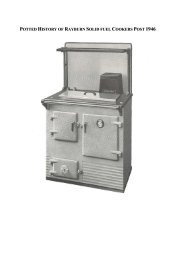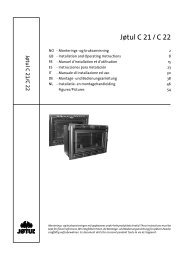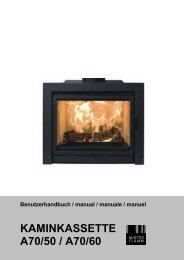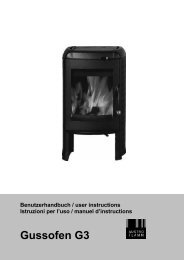Morsø 6100
Morsø 6100
Morsø 6100
Create successful ePaper yourself
Turn your PDF publications into a flip-book with our unique Google optimized e-Paper software.
We recommend that the stove be installed at least 10-15 cm from masonry in order to allowheat to circulate and to facilitate the cleaning of the inside and outside of the stove. A layer ofwallpaper on a brick wall is normally regarded as non-flammable material.The floorIf the stove is installed on a flammable floor, national and local regulations must be observedwith regard to the size of the non-flammable underlying surface that must cover the floorbeneath the stove.The underlying surface must naturally be able to bear the weight of the stove and, if applicable,the steel chimney.Distance to furnitureWe recommend that the stove be installed 900 mm from furniture, but consideration shouldalso be given to whether furniture, etc., will dry out as a result of its proximity to the stove.The distance to flammable material in front of the stove is 900 mm.A wood-burning stove gets hot when it is fired. Caution must therefore be observed,particularly with regard to children touching the stove.1.5 The chimneyIf local regulations permit, the stove may be connected to a chimney already serving anotherfireplace (such as an oil-burning stove or another wood-burning stove). Attention should bepaid to any requirements concerning the location of flue pipes if two or more fireplaces areconnected to the same chimney.The wood-burning stove must never be connected to a chimney to which a gas-burning stoveis already connected. An efficient, modern stove places great demands on the chimney, sohave a chimney sweep check the condition of your chimney.The aperture of the chimney must comply with national and local regulations. In general, theaperture area should measure at least 175 cm2 for wood-burning stoves.An overly large chimney aperture will mean that too much energy will be required to heat thechimney sufficiently to achieve an acceptable draught. If you have a brick chimney with alarge aperture, we recommend that you install an insulating chimney liner of the proper diameter.This will increase the draught, and improve the fuel economy.There are no requirements with respect to specific chimney heights, but a chimney must betall enough to provide a good draught, and to ensure that the smoke does not cause anyproblems. As a general rule, there will be a satisfactory draught if the chimney extends 4metres above the stove and at least 80 cm above the spine of the roof. If the chimney is locatedalong the side of the house, the top of the chimney should never be lower than thespine of the roof or the highest point on the roof. Please note that there are often national andlocal regulations regulating the location of chimneys in houses with thatched roofs. Pleasesee section 1.9 Draught.The chimney and the flue pipe must be fitted with cleaning doors, which must be at least thesame size as the chimney’s aperture area.The chimney must be accessible for external inspection, and it must be possible to accessthe cleaning doors and the chimney if it is to be cleaned from the top (e.g. steel chimneys).22


